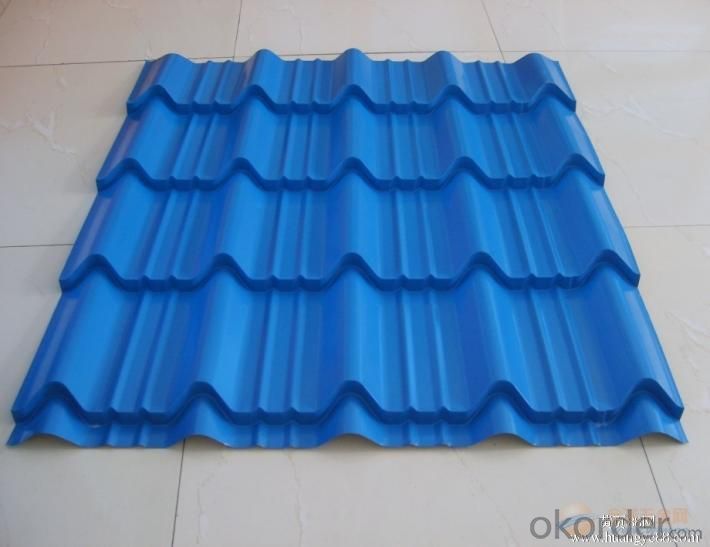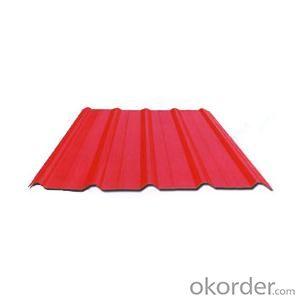Pre-Painted Galvanized/Aluzinc Steel Roof with Good Price
- Loading Port:
- Tianjin
- Payment Terms:
- TT OR LC
- Min Order Qty:
- 50 m.t.
- Supply Capability:
- 10000 m.t./month
OKorder Service Pledge
OKorder Financial Service
You Might Also Like
1. Pre-Painted Galvanized/Aluzinc Steel Roof Description:
With GI as base material, after pretreatment (degrease and chemical treatment ) and liquid dope with several layers of color, then after firing and cooling, finally the plate steel is called pre-painted galvanized (aluzinc) steel. Pre-painted galvanized roof is good capable of decoration, molding, corrosion resistance. It generally displays superior workability, durability and weather resistance.
2.Main Features of the Pre-Painted Galvanized/Aluzinc Steel Roof:
• Excellent process capability
• Smooth and flat surface
• Workability, durability
• Excellent heat resistance performance
• High strength
• Good formability
• Good visual effect
3.Pre-Painted Galvanized/Aluzinc Steel Roof Images


4.Pre-Painted Galvanized/Aluzinc Steel Roof Specification
Standard: AISI, ASTM, BS, DIN, GB, JIS
Grade: SGCC SGCH SGCD DX51D
Thickness: 0.13-3.0mm
Model Number: AISI, ASTM, BS, DIN, GB, JIS
Type: Steel Plate
Technique: Cold Rolled
Surface Treatment: Galvanized
Application: Container Plate
Special Use: High-strength Steel Plate
Width: 30-1500mm
Length: any length
color: RAL color
5.FAQ of Pre-Painted Galvanized/Aluzinc Steel Roof
What’s the brand of the paint?
We use the best brand of all of the word—AKZO.
What’s the wet and heat resistance of the roof?
More than 1000 hours.
- Q:What are some characteristics of steel.
- Characteristics Of Steel Hardening. - The characteristic difference between steel and pure wrought iron is as follows: - When steel is raised to a red heat and then suddenly cooled, it becomes hard and brittle. This process, which is known as hardening, has no effect upon pure wrought iron. Tempering is a characteristic of steel which distinguishes it from cast iron. If steel has been hardened by being heated and suddenly cooled, as above described, it may be softened again by applying a lower degree of heat and again cooling. This is known as tempering. Cast iron, on the contrary, though it is hardened by the first process, cannot be softened by the second. When a bar of steel is struck it gives out a sharp metallic ring, quite different from the sound produced by striking wrought iron. Other characteristics of steel are its great elasticity and its retention of magnetism.
- Q:What are the common standards and specifications for steel coils?
- There are several common standards and specifications for steel coils that are widely recognized and used in the industry. Some of the most common ones include: 1. ASTM A36/A36M: This specification covers carbon structural steel shapes, plates, and bars of structural quality for use in riveted, bolted, or welded construction. 2. ASTM A572/A572M: This specification covers high-strength low-alloy columbium-vanadium structural steel shapes, plates, sheet piling, and bars for applications in bolted, riveted, or welded construction. 3. ASTM A653/A653M: This specification covers steel sheet, zinc-coated (galvanized) or zinc-iron alloy-coated (galvannealed) by the hot-dip process. 4. ASTM A1011/A1011M: This specification covers hot-rolled, carbon, structural, high-strength low-alloy, high-strength low-alloy with improved formability, and ultra-high strength steel sheet and strip in coils. 5. JIS G3302: This Japanese Industrial Standard specifies the requirements for hot-dip zinc-coated steel sheet (galvanized steel sheet) and strip. 6. EN 10111: This European standard specifies the requirements for continuously hot-rolled low carbon steel sheet and strip for cold forming. 7. ISO 3575: This International Organization for Standardization standard specifies the requirements for hot-dip zinc-coated and zinc-iron alloy-coated steel sheet and strip. These are just a few examples of the common standards and specifications used for steel coils. It is important to note that different industries and applications may have specific requirements, so it is always advisable to consult the relevant standards and specifications for the specific application.
- Q:How are steel coils inspected for dimensional accuracy during processing?
- Steel coils are inspected for dimensional accuracy during processing using various methods such as laser measuring systems, ultrasonic thickness gauges, and calipers. These tools are used to measure the width, thickness, and diameter of the coils to ensure they meet the required specifications. Additionally, visual inspections are also conducted to identify any irregularities or defects in the coils.
- Q:benchmade mpr with m390 steel knife. Is it better than d2 s30v or 154cm steel?
- From what I read M390 is relatively wear resistant, with very high stain resistance and good toughness. It is quite hard to qualify steel as better than other steel because it depends on many factors. E.g. for a small folder designed for delicate cutting D2 at high hardness would perform better, but if the environment is corrosive, like saltwater then M390 would be better. I'm not so sure about using stainless steels in large chopping style knives, but I've seen M390 used for them as well. Obviously hardness had to be lowered, which reduces edge holding ability, especially at low angles. Overall, it's a good steel, but if it will outperform S30V or D2 or 154Cm depends on heat treatment and blade geometry, knife designed use, etc.
- Q:What are the different types of steel coil handling equipment?
- Some different types of steel coil handling equipment include coil lifters, coil tongs, coil grabs, coil hooks, coil transfer cars, and coil upenders. These equipment are designed to safely lift, transport, and rotate steel coils during various industrial processes.
- Q:What are the common coil transportation options?
- Common coil transportation options include using flatbed trucks, rail transportation, and cargo ships. Flatbed trucks are commonly used for shorter distances and provide easy loading and unloading of coils. Rail transportation is often used for longer distances, offering cost-effective and efficient transportation. Cargo ships are utilized for international shipments, allowing for large quantities of coils to be transported across long distances.
- Q:why does steel have a density range when other metals do not?
- Steel is not a pure element it is an alloy. Steel is primarily iron but it has many elements blended in that change it's density including carbon,silicon, nickel, chrome, etc. Aluminum and copper , magnesium and so forth can be the pure element or they can be alloys too. If they are alloys, then their densities vary also
- Q:What is the purpose of steel coils?
- The purpose of steel coils is to efficiently store and transport large quantities of steel in a compact and organized manner.
- Q:What are the different types of steel coil handling systems?
- There are several types of steel coil handling systems, including overhead crane systems, coil grab systems, coil transfer cars, and coil tilters. Each system is designed to efficiently and safely handle steel coils in different environments and applications.
- Q:Can steel coils be customized in terms of size and shape?
- Yes, steel coils can be customized in terms of both size and shape to meet specific requirements and applications.
1. Manufacturer Overview |
|
|---|---|
| Location | |
| Year Established | |
| Annual Output Value | |
| Main Markets | |
| Company Certifications | |
2. Manufacturer Certificates |
|
|---|---|
| a) Certification Name | |
| Range | |
| Reference | |
| Validity Period | |
3. Manufacturer Capability |
|
|---|---|
| a)Trade Capacity | |
| Nearest Port | |
| Export Percentage | |
| No.of Employees in Trade Department | |
| Language Spoken: | |
| b)Factory Information | |
| Factory Size: | |
| No. of Production Lines | |
| Contract Manufacturing | |
| Product Price Range | |
Send your message to us
Pre-Painted Galvanized/Aluzinc Steel Roof with Good Price
- Loading Port:
- Tianjin
- Payment Terms:
- TT OR LC
- Min Order Qty:
- 50 m.t.
- Supply Capability:
- 10000 m.t./month
OKorder Service Pledge
OKorder Financial Service
Similar products
New products
Hot products
Hot Searches
Related keywords





























